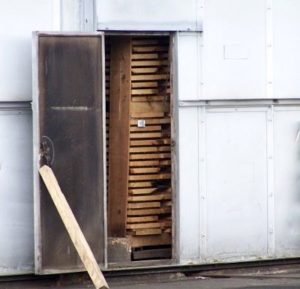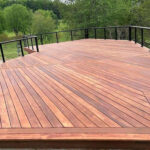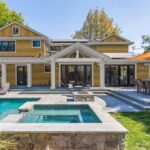
Wood is an organic and hydroscopic material. Think of it like a bundle of straws. It will take in moisture and expel moisture as the humidity of it’s environment changes. The capillary action of the wood takes in the moisture causing the fibers to swell and the wood moves across the grain. It is this essential element of wood that makes working with it so wonderful and at the same time frustrating. A proper understanding of how wood moves is an absolutely necessity to avoid warping and cupping once your project is finished. In the worst instances, projects have self destructed when the wood was not given room to expand. No matter what you do, you cannot stop the wood from moving and you must always accommodate it. The clever woodworker will embrace this movement and use it to create even stronger joints. Regardless of your trade, starting with properly dried lumber will make the job so much easier. Properly dried lumber will still move but it is overall more stable and predictable. J. Gibson McIlvain takes this drying process very seriously and we pride ourselves on the quality of our lumber because of this careful attention to detail. Drying lumber cannot be rushed and we have found that a controlled, multi-step process yields the best lumber.
Drying Lumber For Your Region
Various climates demand different amounts of moisture for stable lumber. In North America our standard is 6-8% for kiln dried lumber. This number may climb based upon your local conditions but properly kiln dried lumber will fluctuate very near this range. Europe has a wetter climate and therefore their lumber is happy in the 12-15% range. More than just matching the local range is important here though. The process of kiln drying will harden the lignin (the stuff between the cell walls in wood) and set it in place. While the wood will still take on moisture and expel it, the cell walls are not as flexible and thus the wood will not move as dramatically. In essence, kiln drying reduces the wood’s ability to move making it more stable.
Case Hardening Wood
Setting the lignin like this can have drawbacks if done too quickly however. This is called case hardening. When the wood dries the outer layers dry faster than the inner layers. If the outer layer “sets” up too fast it creates a hard shell around the inner layers and traps the moisture inside. This wood is very unstable and will move dramatically when cut. Cracking and discoloration will occur on the outer layers and is usually a sign that case hardening has occurred. Kiln drying is a fine line that can go very wrong if done too much and too fast.
Kiln Drying Wood Should be slow and controlled

Our drying process is no trade secret and in most cases drying schedules for species are commonly published properties. We find that in today’s rush rush supply and demand world that steps can get forgotten or skipped in order to get the product out the door. J. Gibson McIlvain puts a lot of time into drying our lumber so we can be sure it is the best when it leaves our yard.
We receive lumber from all over the world. Some is green and recently sawn with 25-50% moisture content. Most imports are dried to European standards and are 12-15%. Finally some domestics are air dried and vary from 10-25% moisture. Each instance requires different handling but we have found that the same process can be applied to each with variance in the total time from arrival to dry and ready for sale.
Air Drying
The back corner of our Maryland and lumber yards is dedicated to air drying. All of our lumber spends some time stacked and stickered back there.

Stickers are small spacers that go between the boards to allow even air flow around the entire board thus creating an even release of moisture. The wetter the wood, the longer it will sit and air dry. The ends of boards are painted or waxed to slow the release of moisture from the end (remember the bundle of straws analogy) and prevent checks and cracks. Air drying is very gentle on the wood and it is a safe way to release the bulk of the excess moisture. This process does not “set” the lignin like kiln drying so air dried wood while softer and easier to work will not be as stable. Air drying first allows our wood to come into a kind of equilibrium with our local climate and prepares it for the kilns. Wood can sit in our air drying yard for a few weeks or the better part of a year depending on how wet it is upon arrival.
Kiln Drying
Once the wood is settled down with the local climate, we can safely move it to one of our 10 dry kilns. The goal being that 6-8% moisture level. The kilns are powered by a boiler that is in turn heated by the offcuts and dust we generate in our own mill making them very efficient and a green, useful way to dispose of our own waste.

The temperature and time the wood is in the kiln depends upon the species being dried. The denser woods need more time and can be in the kiln in excess of a month; whereas the less dense species may only be in the kiln a few weeks. Some species require even more special handling. Spanish Cedar is a good example. This wood is highly resinous and prone to weeping each time it is cut. The sticky resin stains the wood and makes finishing nearly impossible. We have some of the only kilns in North America capable of getting hot enough to set this sap and resin to prevent this weeping. With the higher temperature comes a greater chance of case hardening so slow heat up and cool down is important thus extending the overall time Spanish Cedar spends in the kiln.
So much is at stake when drying lumber. Taking the process too fast will destroy the lumber. Sometimes the damage to the lumber caused by improper drying isn’t evident until your project is well underway. The difficulties and delays from misbehaving lumber is costly and always will reflect poorly on us so we take this very seriously. All in all, wood can be used in many different states of wet and dry. The key is understanding how it behaves in these states and taking measures to ensure the resulting movement won’t cause problems later on. J. Gibson McIlvain has lumber across the spectrum from very wet to completely dry and we can accommodate your needs whatever they be.









I am hoping for a bit of advice. We bought kiln dried sapele (not from yourselves) to make an external door. It is a framed, ledged and braced door. All the joints are biscuit joints. It was given a paint finish and has been in place for about 9 months. However, it has started to open up on the joints in the last three months (wet and cold weather) and twice we have had to make adjustments to it. I read you articles on kiln drying with interest but the timber behaviour does not seem to be in keeping with what you say.
Exterior doors are tough because they go through brutal weather changes. Careful selection of the lumber is imperative. Using quartersawn material for the rails and stiles is necessary so that the expansion and contraction occurs across the thickness of the pieces and not across the width where it will cause the joints to open up like you are indicating. Moreover, most of the door manufacturers I have dealt with do not use biscuits but rather mortise and tenon joinery, usually with a cope and stick profile as a way of housing the joint and controlling gaps. But the joinery is a secondary issue to using quartered boards on at least the stiles of the door.